Pushpin MIDI interface update (Still no success)
December 1st, 2007To make a long story short:
The bad news is I still haven’t come up with working design. The good news is that I think my problem is with my MIDI interface (A Radium49 keyboard) I tried several opto-couplers, and I couldn’t get the 6n13x’s to give the slightest hint of a signal on the other side. Admittedly, I didn’t find a 6n138 at the lab, so all I tried was 6n136, 6n137 and 6n139, which should all be good for MIDI. This was something I double checked with an oscilloscope, but no reaction.
I also tried a CNY17-3, which did work, but only barely (Sometimes copied the data corrupted)
I think my Radium has too much resistance, so that the current it can gives cannot drive the LED in the opto-coupler. (The alternative is that I just suck and should give up :p ) Some day maybe I’ll check inside. But my next attempt will be to find another MIDI device to check if I was correct.
Until then, stay tuned.
Pushpin Gameboy MIDI cable build report (Failed)
November 29th, 2007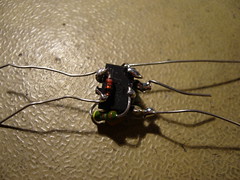
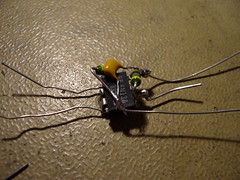
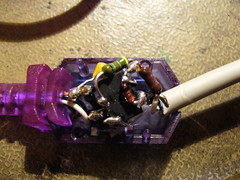
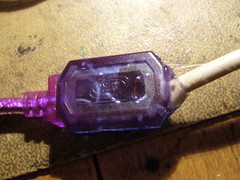
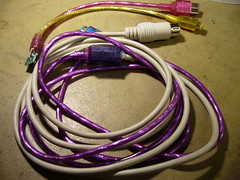
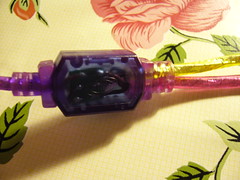
Lower right picture: Original junction box.
Summary: If you bought the components listed on my instruction page, you may want to wait a little for further instructions before you put it together. Some things may be wrong in that schemativ (Most probably resistor values.)
Time for a build report of my brand new Pushpin MIDI cable. First the positive things: I managed to build it as planned, and fit it into smoothly into the little plastic junctions box. The reason I did it this was because I was inspired by AlphA’s ninja style soldering.
It even went so smooth, and looked so nice that I was convinced that it would work right away. Unfortunately, no even close to the truth!
Pushpin didn’t react at all. After testing a lot of different things, I finally ripped the box open again. I had connected the MIDI cable the wrong way around. Damn. And the circuit, as you can see, is very compact, and was also glued to the box to keep it stable. I was forced to clean off the pins and connect the MIDI to the opto-coupler LED withut any additional components. Still didn’t work.
It was about at that time I started to work on a simple test program to indicate whether there is any traffic on the so called SD pin on the link port, which is what Pushpin is using to read MIDI data. The program can be downloaded here: SD Pin Monitor. However, when trying it out, my sound card suddenly stopped working. No$gmb froze when using sound, and most other programs returned an error. I have no clue why. A reboot helped, but it still delayed me a bit.
Still didn’t work. It was not until I connected the MIDI straight to link port that things started giving a hint of working. (MIDI Gnd <-> GB Gnd and MIDI signal <-> GB SD pin) Doing it that way, the test program started responding. Even Pushpin started playing a couple of random notes, although it was nothing of what I actually played, and it was a bit random, not every note returned a sound from PP.
So, here I am, with my cable interface destroyed, not knowing what the problem was. It’s annoying because there are several possible error sources, like:
- Badly timed output from my keyboard (A Radium49)
- Construction error in the adapter I built. (Short circuit or lose contacts)
- Wrong resistor values in my schematic may have blocked the signal somewhere across the way.
I will try to do a more scientific troubleshooting on my school’s lab, where I have access to oscilloscopes and prototype boards, to see if I can trace down the problem. So for now, if you’ve bought the components for the schematic I described before, you may want to wait a while for my results.
On the other hand, it would be cool if one or three people could build my circuit to see if it was just something I did wrong when I built mine. I don’t know. In not too long, we’ll know.
Pushpin Gameboy MIDI synth now open source!
November 27th, 2007Have you ever heard about the Pushpin Gameboy MIDI synth? It’s a mysterious thing that I first saw maybe around 2000 or 2001. Over the years I’ve tried to reach the creators of this project, but without success. I thought the whole thing was fake, and that the music was perhaps made with LSDj or some other software.
As I know now, that’s not the case, but I wonder why it took them 7 years of silence before getting Pushpin out to the world.
This is an interesting piece of software that I have waited for for a long time now. I’ll build an interface as soon as I can. And I’m also going to try to do what I can to help the project, in terms of hardware and software development.
So far, I’ve written a Pushpin hardware tutorial, which I will update as time goes by.
The program and source code can be downloaded from the Pushpin Google Code page and there’s also documentation on variogr.am.
![You suck at protoshop. No, you [i]really[/i] oo.](http://blog.gg8.se/images/you-suck-at-photoshop-you-really-do-your-awful.png)


